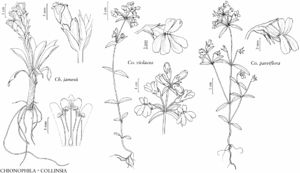Collinsia violacea
Trans. Amer. Philos. Soc., n. s. 5: 179. 1835.
Annuals 10–35(–60) cm. Stems erect to ascending. Leaf blades oblong to lanceolate, margins entire or weakly serrate. Inflorescences glabrous or glandular to scaly-hairy; nodes 1–6(–8)-flowered; flowers not crowded proximally, sometimes crowded distally; distalmost bracts linear, 5–6(+) mm. Pedicels ascending to reflexed, usually longer than calyx, visible, glandular abaxially and adaxially. Flowers: caly× lobes deltate, surpassing capsule, ape× acuminate; corolla violet, banner pale violet to white, base yellow with dark orange spot, wings and keel violet, 10–15 mm, keel glabrous or sparsely glandular; banner length 0.6–0.7(–0.8) times wings, lobe base without folds; wings narrowly obcordate, notched 0.2 times whole length; throat slightly angled to tube, longer than diam., pouch arched, slightly expanded; stamens: abaxial filaments glabrous, adaxials hairy, basal spur 0. Capsules without red blotches. Seeds 6–12, oblong to oval, 1–1.5 mm, margins thickened, inrolled. 2n = 14.
Phenology: Flowering Apr–Jun.
Habitat: Sandy or rocky soils, dry open areas, woodlands.
Elevation: 10–300 m.
Distribution
Ark., Ill., Kans., Mo., Okla., Tex.
Discussion
Selected References
None.
